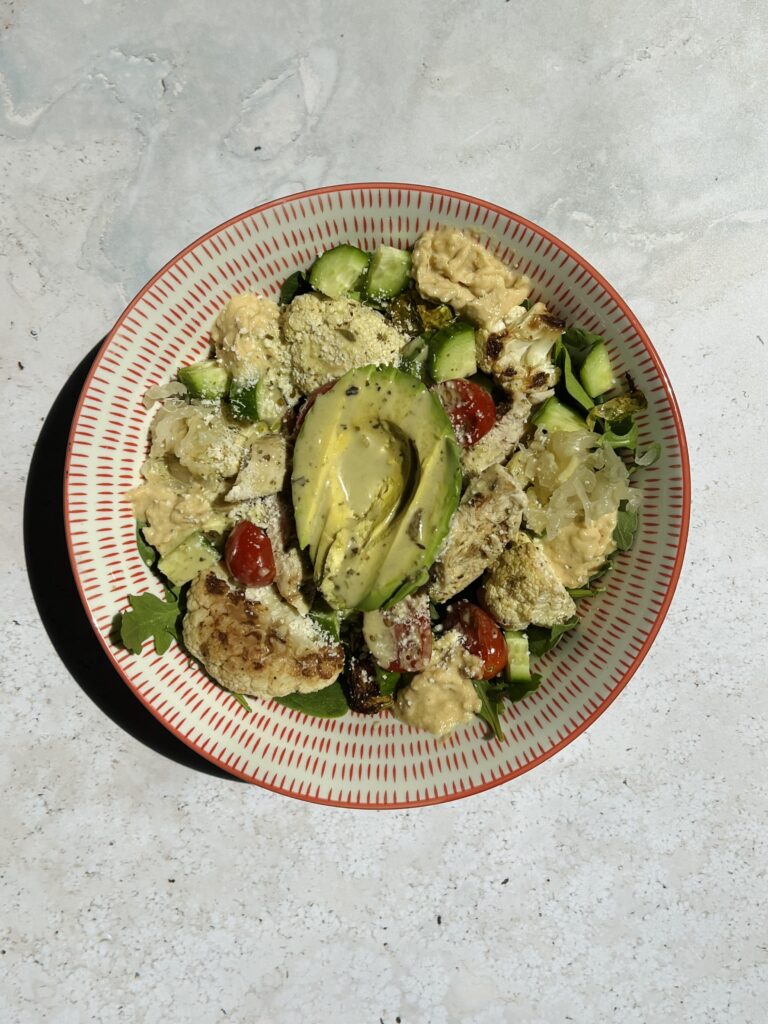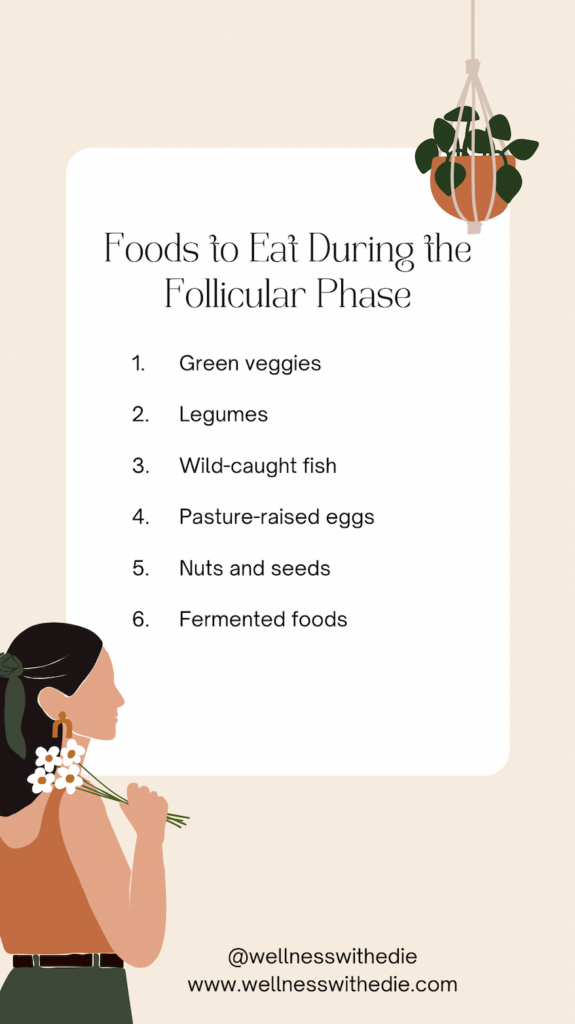Want a healthier menstrual cycle? Prioritize what’s on your plate. Study after study shows that nutrition directly impacts hormone health. But between the busyness of work and other responsibilities, proper nourishment becomes an afterthought. In turn, we reach for what’s convenient. And often, what’s convenient is packed with inflammatory oils. But fueling your body with nourishing foods is integral to a normal period. It also significantly improves fertility. Today, we’re specifically focusing on the first half of the menstrual cycle: the follicular phase. Good news! Eating to support this phase is delicious. Hello, heart-healthy fish, plant-based ingredients, and fermented foods.

four phases of the menstrual cycle
As women, our bodies work similarly to the seasons. At certain times of the month, our energy is higher. We may feel more abundant (spring and summer). Other weeks, we may crave solitude (fall and winter). Just like the seasons, a woman’s menstrual cycle has four distinct phases: menstrual, follicular, ovulatory, and luteal.
• menstrual: the start of your period
• follicular: 7-10 days leading up to ovulation
• ovulatory: 3-5 days of ovulation
• luteal: 10-14 days before your period
What is the follicular phase?
The follicular phase is the longest step in the menstrual cycle. It lasts from the first day of your period to ovulation. As your period ends, you may begin feeling more energetic, inspired, and focused. Now is the time to socialize with friends, start a new project, and be intimate with your partner. As a woman moves into the follicular phase, she’s ready to slowly get back into the world, take on new projects, start planning, and organize. This is an optimal time to dedicate focus on projects, research, learn, and perform physical tasks.

Nutrients the Body Needs During the Follicular Phase
We always want to aim for a wide variety of nutrients. They help boost mood, support stable blood sugar, minimize nutrient deficiencies, balance hormones, and support sleep. During the follicular phase, specifically, you want to focus on nutrients that metabolize estrogen. Estrogen levels naturally rise during this phase, so it’s best to eat foods that help naturally detox. Eating to support the follicular phase also looks like emphasizing the nutrients below.
Omega-3 Fatty Acids
Healthy fats are an important part of any balanced diet, but they’re especially important in relation to women’s health. Omega-3 fatty acids have been shown to reduce the follicle-stimulating hormone (FSH). High FSH levels can have complications relating to your menstrual cycle, including polycystic ovarian syndrome. Omega-3s also act as the starting point for making hormones that regulate blood clotting, inflammation, and more. This is my favorite omega-3 fatty acid supplement. Food sources of omega-3s include mackerel, wild-caught salmon, cod liver oil, sardines, flax seeds, chia seeds, and walnuts.
Fermented Foods
Good gut bacteria is a necessity for the digestive system to break down food and absorb its nutrients. Healthy gut bacteria also plays a vital role in regulating your hormones (especially estrogen). Foods like kimchi, sauerkraut, probiotic-rich yogurt, non-GMO miso, non-GMO tempeh, and sourdough bread are great examples.
Magnesium
There is a fluctuation of certain minerals during the menstrual cycle, and magnesium levels are lowest during the follicular phase. Consuming magnesium-rich foods during this time can help magnesium and its role in metabolizing estrogen. This is my favorite topical magnesium.
Fiber
Most Americans don’t consume nearly enough fiber, but this nutrient is especially important for women’s health. It is associated with healthy digestion, but high fiber intake can also reduce the levels of estrogen in the body. All produce is rich in fiber, as are legumes, nuts, and seeds.
Salad idea for the follicular phase
Leafy greens (spinach, arugula, Romaine, etc.), shredded chicken, roasted cauliflower and Brussels sprouts, cucumber, tomatoes, sauerkraut, avocado, grated parmesan cheese, hummus, and cilantro-lime dressing. Get the full recipe here.
Foods to eat during the follicular phase
When it comes to eating to support the follicular phase, prioritize foods that provide a win-win: support follicle development and help metabolize estrogen. Examples: green vegetables, raw carrots, nuts, seeds, eggs, fish, and legumes. Cruciferous vegetables—like kale, cabbage, broccoli, and cauliflower—are packed with a phytonutrient called DIM, which helps normalize estrogen levels. Seed cycling is particularly helpful during this phase, too!
Keep Blood sugar balanced for a healthy menstrual cycle
Last but not least—when it comes to supporting a healthy follicular phase—keep your blood sugar in check. Try to minimize long stretches without eating. This disrupts blood sugar balance, which disrupts hormone health. Most women need to eat every 3-4 hours to manage blood sugar levels and avoid cortisol spikes / mood swings! And when eating carbohydrates, pair them with a source of protein and / or healthy fats to keep blood sugar stable.

Hormone balance ebook
Ready to take the next step in your hormone-healing journey? Grab your copy of Master Your Menstrual Cycle—my holistic guide to balancing your hormones with ease. Available for only $15!
This post contains affiliate links. Thank you for supporting Wellness with Edie! This article is for informational purposes only. It is not, nor is it intended to be, a substitute for professional medical advice, diagnosis, or treatment and we recommend that you always consult with your healthcare provider.



Leave a Reply